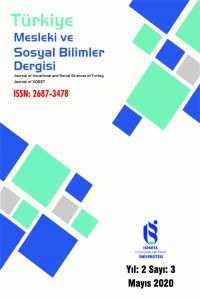Öz
Avatar filmi, sanal / gerçek beden düalizminin temsilinin önemli bir örneğidir ve sanal kimlikler ve doğal/sanal ikili karşıt konumu fenomenolojik bir yaklaşım kullanarak konunun ele alınmasına olanak sağlamaktadır. Sanal bedenin konumunu ve toplumdaki yerini belirlerken, deneyimleri ve kimlik oluşumlarıyla toplumun sanal alanda bireysel terimlerle nasıl işlediğini anlamak mümkün olabilmektedir. Çalışma, sanal beden / kimlik inşası sürecindeki kilit aktörleri tanımlamaya yardımcı olmakta ve aynı zamanda filmin kendisinde olduğu gibi sanal ve doğal olan ikiliğe dikkat çekmektedir.
Anahtar Kelimeler
Kaynakça
- Apter, E. (2008). “Technics of the Subject: The Avatar-Drive.” Postmodern Culture, Volume 18, Number 2.
- Balsamo, A. (1993) “The Virtual Body in Cyberspace.” Journal of Research in the Philosophy of Technology.
- Craig, R. T. (1999). “Communication Theory as a Field,” Communication Theory, 9, 2, 119-161. Deleuze, G. (1989) Cinema 2. London.
- Evans, D. (1996). An Introductory Dictionary of Lacanian Psychoanalysis. London New York. (Figure 1)
- Ihde, D. (1998). “Virtual Bodies.” Body and Flesh: A Philosophical Reader. Ed. Donn Welton. Blackwell Publishing. Lacan, J. (1949) “The mirror stage as formative of the function of the I as revealed in psychoanalytic experience.” Delivered at the 16th International Congress of Psychoanalysis, Zurich, July 17, 1949.
- Littlejohn, S. W. & Foss, K. A. (2008). Theories of Human Communication. USA: Thomson-Wadsworth.
- Shaviro, S. (1993) The Cinematic Body. University of Minnesota.
- Heidegger, M. (1962). Being and Time. USA: Harper & Row.
- Sobchack, V. (2009) “Phenomenology,” The Routledge Companion to Philosophy and Film. 435-445.
- Watson, S. (2009) “In the Shadow of Phenomenology.” Continuum International Publishing Group. NY.
Öz
The film Avatar is a distinct example of the representation of the virtual/actual body dualism and can provide an understanding of the matter through the use of phenomenological approach to address the issues of virtual identities and nature/virtual binary opposition. As we identify the position of the virtual body and its position in society, it might be possible to understand how society functions in individual terms in virtual space with their experiences and identity formations. The study will help identify key actors in the process of virtual body/identity construction and also look into the disguise of the binary opposition of virtual vs. natural as evident in the film itself.
Anahtar Kelimeler
Kaynakça
- Apter, E. (2008). “Technics of the Subject: The Avatar-Drive.” Postmodern Culture, Volume 18, Number 2.
- Balsamo, A. (1993) “The Virtual Body in Cyberspace.” Journal of Research in the Philosophy of Technology.
- Craig, R. T. (1999). “Communication Theory as a Field,” Communication Theory, 9, 2, 119-161. Deleuze, G. (1989) Cinema 2. London.
- Evans, D. (1996). An Introductory Dictionary of Lacanian Psychoanalysis. London New York. (Figure 1)
- Ihde, D. (1998). “Virtual Bodies.” Body and Flesh: A Philosophical Reader. Ed. Donn Welton. Blackwell Publishing. Lacan, J. (1949) “The mirror stage as formative of the function of the I as revealed in psychoanalytic experience.” Delivered at the 16th International Congress of Psychoanalysis, Zurich, July 17, 1949.
- Littlejohn, S. W. & Foss, K. A. (2008). Theories of Human Communication. USA: Thomson-Wadsworth.
- Shaviro, S. (1993) The Cinematic Body. University of Minnesota.
- Heidegger, M. (1962). Being and Time. USA: Harper & Row.
- Sobchack, V. (2009) “Phenomenology,” The Routledge Companion to Philosophy and Film. 435-445.
- Watson, S. (2009) “In the Shadow of Phenomenology.” Continuum International Publishing Group. NY.
Ayrıntılar
| Birincil Dil | İngilizce |
|---|---|
| Konular | Radyo-Televizyon |
| Bölüm | Araştırma Makaleleri |
| Yazarlar | |
| Yayımlanma Tarihi | 28 Mayıs 2020 |
| Gönderilme Tarihi | 6 Mart 2020 |
| Yayımlandığı Sayı | Yıl 2020 Sayı: 3 |


